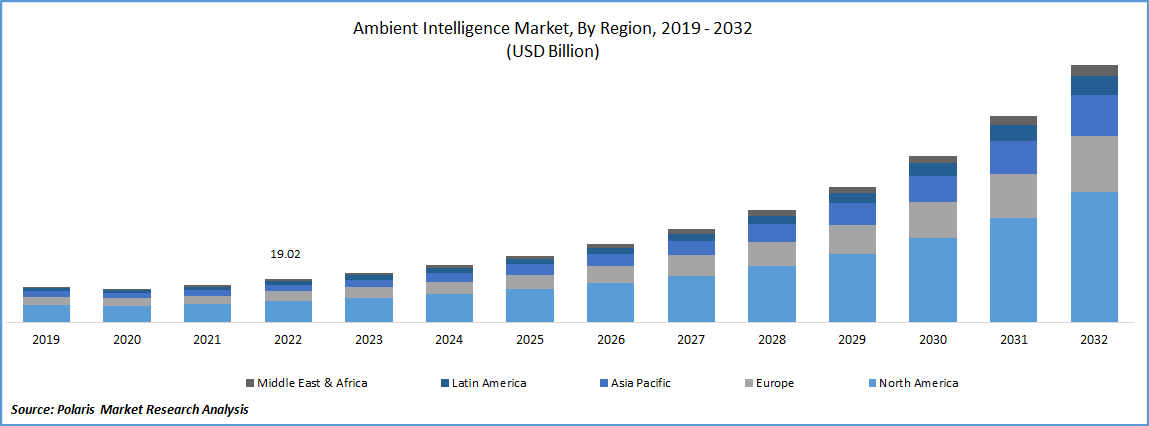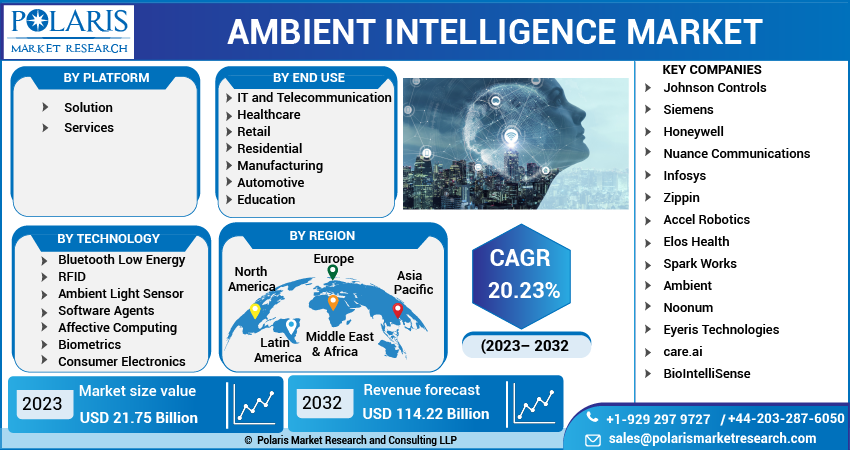
Ambient Intelligence Market Size, Share & Trends Analysis Report
By Platform (Solution, Services), By Technology, By End-use Industry, By Region, And Segment Forecasts, 2023-2032
- Published Date:Jun-2023
- Pages: 118
- Format: PDF
- Report ID: PM3390
- Base Year: 2022
- Historical Data: 2019-2021
Report Outlook
The global ambient intelligence market was valued at USD 19.02 billion in 2022 and is expected to grow at a CAGR of 20.23% during the forecast period. Proliferation of Internet of Things (IoT) devices has resulted in an explosion of data generated by these intelligence devices, which can be used to develop ambient intelligence systems that can learn and adapt to user behaviour and preferences. By using AI technology, this data can be analysed in real-time to provide insights and automate tasks, leading to improved user experience and greater efficiency.

To Understand More About this Research: Request a Free Sample Report
As pe the estimates of the United Nations (UN) around 70 percent of the world population expected to reside in urban and sub-urban settings. This trend presents a significant challenge for cities and urban areas, as they must find ways to manage the increasing population density and associated demands for transportation, energy, and resources. AmI systems can play a crucial role in addressing these challenges by creating smart urban transportation networks that improve transportation efficiency, reduce congestion, and promote eco-friendly modes of transportation. For instance, AmI can provide real-time traffic information, optimize routes, and facilitate the use of public transportation or car-sharing services, reducing the number of vehicles on the road and improving overall transportation efficiency.
Smart homes and buildings are one of the key applications of ambient intelligence, as they can provide a more convenient and energy-efficient living and working environment. By integrating IoT devices such as smart thermo-stats, lighting, security systems, and AI enabled appliances, AI can learn the user's preferences and adjust the environment accordingly, leading to greater energy efficiency and cost savings. For instance, smart thermostats can adjust the temperature based on the user's behaviour and preferences, while smart lighting can automatically turn off when the user leaves the room.
Integration of IoT devices and AI technology in ambient intelligence systems can provide numerous benefits, including improved user experience, greater efficiency, and cost savings. As the demand for smart homes and buildings continues to grow, the adoption of these technologies is expected to increase, leading to even more innovative and intelligent environments.

For Specific Research Requirements, Request for a Sample Report
Industry Dynamics
Growth Drivers
Ambient Intelligence (AmI) has the potential to transform the way we live, work, and interact with our environment, especially in the context of smart cities and smart homes. Smart city projects leverage AmI to monitor and control various aspects of urban life, such as traffic flow, energy consumption, and waste management, with the goal of creating a more sustainable, efficient, and liveable environment. In the case of smart homes, AmI technologies can create intelligent environments that adapt to the changing needs and preferences of the users, providing a more seamless and convenient experience. For example, smart homes can automatically adjust the lighting, temperature, and entertainment systems based on the user's behaviour and preferences. AmI can also monitor and control energy consumption, optimize waste management, and improve home security.
Report Segmentation
The market is primarily segmented platform, technology, end use, and region.
|
By Platform |
By Technology |
B End Use |
By Region |
|
|
|
|
To Understand the Scope of this Report: Speak to Analyst
Solutions Segment Held Largest Share in the Global Market in 2022
In 2022, solution segment accounted for the largest share. Segment’s growth is attributed to the development of smart devices that provide an improved virtual experience for day-to-day tasks. This includes the development of various IoT devices that are capable of collecting and analysing data to provide insights and automate tasks, leading to greater convenience and efficiency for users.
It includes both hardware and software components. The hardware component of ambient intelligence solutions refers to the specific sensors, components, and devices that are used to collect and process data. These may include sensors for temperature, humidity, light, motion, and sound, as well as smart appliances, cameras, and other devices that can be integrated into a smart environment. Development of innovative hardware and software solutions that can create intelligent environments capable of learning, adapting, and responding to user behaviour and preferences. This trend is expected to continue in the coming years as more and more companies invest in the development of smart devices and solutions to meet the growing demand for ambient intelligence technology.
Services segment exhibited robust growth rate. It incudes substantial demand in the allied services such as integration of various devices and sensors into an existing network infrastructure, as well as the configuration of software applications and platforms to enable seamless communication and data exchange.
Affective Computing Segment is Dominating the Global Market in 2022
In 2022, the affective computing segment garnered the largest share. This is primarily due to its ability analysing human emotions, with the advancements in technology such as more powerful processors, sensors, and machine learning algorithms, it has become possible to develop systems that can recognize and interpret human emotions. The field of affective computing is focused on developing systems and devices that can sense, interpret, and respond to human emotions. Affective computing relies on various sensors such as cameras, microphones, and biometric sensors to capture data related to a person's emotional state. This data can then be analysed using machine learning algorithms and other AI techniques to determine the person's emotional state, such as happiness, sadness, anger, or fear.
RFID segment registered the highest growth rate over the study period. For example, RFID tags can be used to automatically track inventory levels in real-time, allowing businesses to quickly identify when stock levels are running low and order new supplies. This can help to reduce the likelihood of stockouts, improve order fulfilment rates, and ultimately improve customer satisfaction.
Healthcare Segment Held Largest Share in the Global Market in 2022
In 2022, healthcare segment accounted for the largest share. Ambient based assisted living, tele-monitoring of patients, and vital signs sensors are gaining popularity across the globe. These technologies are being increasingly used in healthcare to monitor patients remotely and provide care outside of traditional healthcare settings.
RPM applications and sensors can be used to monitor patients' vital signs, such as heart rate, blood pressure, and oxygen levels, from a distance. This can help to detect health problems early and allow healthcare providers to intervene before a patient's condition worsens. RPM can also be used to monitor patients' medication adherence, reducing the risk of medication errors and improving patient outcomes.
Education segment projected to gain significant traction across the globe. The increased demand for ambient computing in education is driven by the need for more innovative and effective learning experiences that can enhance students' academic achievements and increase access to education. Ambient computing can also be used to create personalized learning experiences that can adapt to the individual needs and learning styles of students. By using sensors and machine learning algorithms, ambient computing systems can track students' progress and provide feedback and recommendations based on their performance.
North America Accounted for the Largest Revenue Share in 2022
In the fiscal year 2022, North America is expected to lead the global ambient intelligence market with Major share. Region’s growth is primarily due the presence of smart home product providers offering a range of ambient computing devices that can be used to control and monitor various aspects of a home, including lighting, heating, air conditioning, and security systems. As per the estimates of the International Energy Agency (IEA), investments in the smart electricity grids in the U.S. alone, has risen by nearly, 10 percent, from 2021. This has attracted investors in the region to inject into the energy management sectors.
In addition to energy efficiency, smart home product providers are also offering ambient computing devices that can enhance home security and convenience. For example, smart door locks, cameras, and alarms can be integrated into an ambient computing system, providing remote access, and monitoring capabilities, as well as notifications and alerts in case of security breaches. In line with this, in January 2022, investor Andreessen Horowitz announced the funding of around USD 52 Mn to the Ambient.ai, to develop world’s 1st computer vision AI- based intelligence platform. It can handle hundreds of physical security dangers in real time scenario.
APAC registered the highest growth rate over the study period. The combination of 5G network adoption and edge computing deployments is expected to drive the region’s growth, as businesses and organizations seek to leverage the benefits of these technologies to create more efficient, responsive, and innovative ambient computing systems. These systems can be used in a range of applications, including smart cities, industrial automation, healthcare, and more.
Competitive Insight
The global players include Johnson Controls, Siemens, Honeywell, Nuance Communications, Infosys, Zippin, Accel Robotics, Elos Health, Spark Works, Ambient, Noonum, Eyeris Technologies, care.ai, and BioIntelliSense.
Recent Developments
- In March 2022, Philips introduced its new service for interventional rooms having an ambient experience with its dedicated FlexVision display.
- In January 2022, Lockheed Martin, Cisco & Amazon collaborated to new innovative human machine interface technologies to the NASA’s space missions. This partnership is expected to provide actionable insights with the integration of ambient intelligence to make space travel to less troublesome.
Ambient Intelligence Market Report Scope
|
Report Attributes |
Details |
|
Market size value in 2023 |
USD 21.75 billion |
|
Revenue forecast in 2032 |
USD 114.22 billion |
|
CAGR |
20.23% from 2023 – 2032 |
|
Base year |
2022 |
|
Historical data |
2019– 2021 |
|
Forecast period |
2023– 2032 |
|
Quantitative units |
Revenue in USD billion and CAGR from 2023 to 2032 |
|
Segments covered |
By platform, By technology, By end use, By Region |
|
Regional scope |
North America, Europe, Asia Pacific, Latin America, Middle East & Africa |
|
Key companies |
Johnson Controls, Siemens, Honeywell, Nuance Communications, Infosys, Zippin, Accel Robotics, Elos Health, Spark Works, Ambient, Noonum, Eyeris Technologies, care.ai, and BioIntelliSense |
FAQ's
The global ambient intelligence market size is expected to reach USD 114.22 billion by 2032.
Key players in the ambient intelligence market are Controls, Siemens, Honeywell, Nuance Communications, Infosys, Zippin, Accel Robotics, Elos Health, Spark Works, Ambient, Noonum, Eyeris Technologies.
North America contribute notably towards the global ambient intelligence market.
The global ambient intelligence market expected to grow at a CAGR of 20.23% during the forecast period.
The ambient intelligence market report covering key segments are platform, technology, end use, and region.
